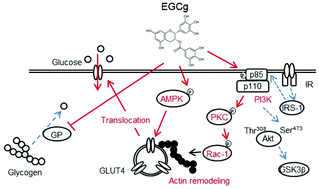当前位置:
X-MOL 学术
›
Food Funct.
›
论文详情
Our official English website, www.x-mol.net, welcomes your feedback! (Note: you will need to create a separate account there.)
Epigallocatechin gallate induces GLUT4 translocation in skeletal muscle through both PI3K- and AMPK-dependent pathways
Food & Function ( IF 6.1 ) Pub Date : 2018-07-05 , DOI: 10.1039/c8fo00807h Manabu Ueda-Wakagi 1, 2, 3, 4, 5 , Kaori Hayashibara 1, 2, 3, 4, 5 , Tomoya Nagano 1, 2, 3, 4, 5 , Masaki Ikeda 1, 2, 3, 4, 5 , Sihao Yuan 1, 2, 3, 4, 5 , Shuji Ueda 1, 2, 3, 4, 5 , Yasuhito Shirai 1, 2, 3, 4, 5 , Ken-ichi Yoshida 1, 2, 3, 4, 5 , Hitoshi Ashida 1, 2, 3, 4, 5
Food & Function ( IF 6.1 ) Pub Date : 2018-07-05 , DOI: 10.1039/c8fo00807h Manabu Ueda-Wakagi 1, 2, 3, 4, 5 , Kaori Hayashibara 1, 2, 3, 4, 5 , Tomoya Nagano 1, 2, 3, 4, 5 , Masaki Ikeda 1, 2, 3, 4, 5 , Sihao Yuan 1, 2, 3, 4, 5 , Shuji Ueda 1, 2, 3, 4, 5 , Yasuhito Shirai 1, 2, 3, 4, 5 , Ken-ichi Yoshida 1, 2, 3, 4, 5 , Hitoshi Ashida 1, 2, 3, 4, 5
Affiliation

|
Our previous report demonstrated that epigallocatechin gallate (EGCg) promotes translocation of glucose transporter 4 (GLUT4) in skeletal muscle. In this study, we investigated the molecular mechanism of GLUT4 translocation by EGCg at the physiological concentration range. In L6 cells, EGCg induced phosphorylation of phosphatidylinositide 3′-kinase (PI3K) and downstream protein kinase C (PKC) λ/ξ without affecting the phosphorylation of insulin receptor and Akt. EGCg-induced GLUT4 translocation was suppressed by RNA interference-mediated knockdown of PI3K and treatment with PKC inhibitor Go6983. Moreover, EGCg increased Rac1 activity and actin remodelling as downstream events of PKCλ/ξ. These results indicate that EGCg induced GLUT4 translocation through a PI3K-dependent pathway, but its mode of action differed from that of insulin. EGCg also induced GLUT4 translocation through a 5′-adenosine monophosphate-activated protein kinase (AMPK)-dependent pathway. 67 kDa laminin receptor, which is a target molecule of EGCg, was not involved in EGCg-induced glucose uptake in L6 cells. The oral administration of EGCg suppressed postprandial hyperglycaemia accompanied by GLUT4 translocation through both PI3K- and AMPK-dependent pathways, and promoted glycogen accumulation in skeletal muscle of ICR mice. EGCg promotes GLUT4 translocation through both PI3K- and AMPK-dependent pathways and glycogen accumulation in skeletal muscle.
中文翻译:

表没食子儿茶素没食子酸酯通过PI3K和AMPK依赖性途径诱导骨骼肌GLUT4易位
我们以前的报告表明,表没食子儿茶素没食子酸酯(EGCg)促进骨骼肌中葡萄糖转运蛋白4(GLUT4)的移位。在这项研究中,我们研究了EGCg在生理浓度范围内GLUT4易位的分子机制。在L6细胞中,EGCg诱导磷脂酰肌醇3'-激酶(PI3K)和下游蛋白激酶C(PKC)λ/ξ的磷酸化,而不影响胰岛素受体和Akt的磷酸化。RNA干扰介导的PI3K的敲低和PKC抑制剂Go6983的处理抑制了EGCg诱导的GLUT4易位。此外,EGCg增加了Rac1活性和肌动蛋白重塑,作为PKCλ/ξ的下游事件。这些结果表明,EGCg通过PI3K依赖性途径诱导GLUT4易位,但其作用方式与胰岛素不同。EGCg还通过5'-腺苷单磷酸激活蛋白激酶(AMPK)依赖性途径诱导GLUT4易位。67 kDa层粘连蛋白受体是EGCg的靶分子,并未参与L6细胞中EGCg诱导的葡萄糖摄取。口服EGCg可通过PI3K和AMPK依赖性途径抑制餐后高血糖,并伴随GLUT4易位,并促进ICR小鼠骨骼肌中糖原的积累。EGCg通过PI3K和AMPK依赖性途径以及骨骼肌糖原积累促进GLUT4易位。口服EGCg可通过PI3K和AMPK依赖性途径抑制餐后高血糖,并伴随GLUT4易位,并促进ICR小鼠骨骼肌中糖原的积累。EGCg通过PI3K和AMPK依赖性途径以及骨骼肌糖原积累促进GLUT4易位。口服EGCg可通过PI3K和AMPK依赖性途径抑制餐后高血糖,并伴随GLUT4易位,并促进ICR小鼠骨骼肌中糖原的积累。EGCg通过PI3K和AMPK依赖性途径以及骨骼肌糖原积累促进GLUT4易位。
更新日期:2018-08-15
中文翻译:

表没食子儿茶素没食子酸酯通过PI3K和AMPK依赖性途径诱导骨骼肌GLUT4易位
我们以前的报告表明,表没食子儿茶素没食子酸酯(EGCg)促进骨骼肌中葡萄糖转运蛋白4(GLUT4)的移位。在这项研究中,我们研究了EGCg在生理浓度范围内GLUT4易位的分子机制。在L6细胞中,EGCg诱导磷脂酰肌醇3'-激酶(PI3K)和下游蛋白激酶C(PKC)λ/ξ的磷酸化,而不影响胰岛素受体和Akt的磷酸化。RNA干扰介导的PI3K的敲低和PKC抑制剂Go6983的处理抑制了EGCg诱导的GLUT4易位。此外,EGCg增加了Rac1活性和肌动蛋白重塑,作为PKCλ/ξ的下游事件。这些结果表明,EGCg通过PI3K依赖性途径诱导GLUT4易位,但其作用方式与胰岛素不同。EGCg还通过5'-腺苷单磷酸激活蛋白激酶(AMPK)依赖性途径诱导GLUT4易位。67 kDa层粘连蛋白受体是EGCg的靶分子,并未参与L6细胞中EGCg诱导的葡萄糖摄取。口服EGCg可通过PI3K和AMPK依赖性途径抑制餐后高血糖,并伴随GLUT4易位,并促进ICR小鼠骨骼肌中糖原的积累。EGCg通过PI3K和AMPK依赖性途径以及骨骼肌糖原积累促进GLUT4易位。口服EGCg可通过PI3K和AMPK依赖性途径抑制餐后高血糖,并伴随GLUT4易位,并促进ICR小鼠骨骼肌中糖原的积累。EGCg通过PI3K和AMPK依赖性途径以及骨骼肌糖原积累促进GLUT4易位。口服EGCg可通过PI3K和AMPK依赖性途径抑制餐后高血糖,并伴随GLUT4易位,并促进ICR小鼠骨骼肌中糖原的积累。EGCg通过PI3K和AMPK依赖性途径以及骨骼肌糖原积累促进GLUT4易位。



























 京公网安备 11010802027423号
京公网安备 11010802027423号